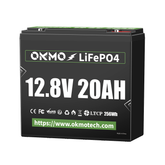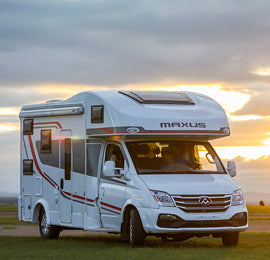How Do You Know Your Battery Is Dead?
When you’re camping, traveling in an RV, boating, or relying on off-grid solar, battery health is one of the most important factors for keeping your system running. But many people still struggle with one basic question: How do you know your battery is dead?
With old lead-acid batteries, the answer was often unclear—voltage dropped unpredictably, lights dimmed, appliances shut off, and users were left guessing what exactly went wrong.
However, with modern LiFePO4 (Lithium Iron Phosphate) batteries, the process is very different. Thanks to built-in BMS (Battery Management System) and, in many cases, Bluetooth mobile monitoring, you can know your battery’s exact condition in real time—long before it becomes “dead.”
This guide explains the true signs of a dying battery, why traditional battery systems make diagnosis difficult, and why modern LiFePO4 batteries give you a major advantage in monitoring, protecting, and understanding your energy system.
1. Why It’s Hard to Know When Old Batteries Are “Dead”
With older lead-acid batteries (AGM, GEL, flooded), users typically rely on symptoms rather than data. Common signs include:
• Dim lights
The voltage drops significantly even at moderate discharge.
• Slow or weak appliances
Water pumps, fridges, and fans operate poorly as the voltage falls.
• Clicking or shutting off of inverters
Inverters stop working when voltage drops too low.
• Battery doesn’t hold charge
Even after charging, power drains quickly.
• Sulfation issues
Buildup inside the battery makes it unable to deliver power, but you can’t see it without equipment.
In short, you guess based on symptoms, because traditional batteries offer poor visibility into their internal condition.
 2. How Modern LiFePO4 Technology Changes Everything
2. How Modern LiFePO4 Technology Changes Everything
LiFePO4 batteries operate fundamentally differently. They provide:
-
Higher usable capacity
-
Flat voltage curve
-
Longer lifespan (3000–5000 cycles)
-
Greater safety
-
Integrated electronics
But the biggest advantage when answering the question “How do you know your battery is dead?” is the built-in Battery Management System (BMS).
 3. The Built-In BMS: Your Real-Time Battery Guardian
3. The Built-In BMS: Your Real-Time Battery Guardian
A high-quality LiFePO4 battery is equipped with a smart BMS that constantly monitors the battery’s internal state.
This system gives users the ability to know:
✓ Battery charge level (State of Charge)
See exactly how much energy is left—no guessing.
✓ Voltage
Measured accurately and in real time.
✓ Current (charging and discharging)
Know how much power is entering or leaving the battery.
✓ Temperature
Critical for preventing overheating or cold-weather damage.
✓ Cell balance status
Ensures all internal cells remain healthy and evenly charged.
✓ Protection status
Such as:
-
Over-charge protection
-
Over-discharge protection
-
Short-circuit protection
-
Over-current protection
-
High/low temperature cut-off
This means a LiFePO4 battery protects itself, and it also tells you exactly what is happening.
 4. Bluetooth Monitoring: The Easiest Way to Know Your Battery’s State
4. Bluetooth Monitoring: The Easiest Way to Know Your Battery’s State
Many LiFePO4 batteries now include Bluetooth connectivity, allowing users to check battery data directly from a smartphone app. No multimeter. No guessing. No opening compartments.
With Bluetooth monitoring, you can instantly view:
• Remaining capacity (Ah and %)
See your exact usage and remaining power.
• Real-time watt usage
Know which devices are drawing the most power.
• Charging status
Solar, alternator, or AC charger details.
• Battery health
View cycles, temperature, and voltage balance.
• Alerts and warnings
The app will tell you if your battery is:
-
Too cold
-
Too hot
-
Overloaded
-
Imbalanced
-
Cut off by BMS protection
This makes it virtually impossible to be surprised by a “dead battery.”
 5. How Do You Know Your LiFePO4 Battery Is Dead? (The Real Answer)
5. How Do You Know Your LiFePO4 Battery Is Dead? (The Real Answer)
Thanks to BMS and Bluetooth monitoring, you’ll know long before your battery actually becomes unusable.
Here are the reliable indicators:
1. The BMS activates low-voltage protection (LVP)
The battery shuts itself off to protect against over-discharge.
The Bluetooth app will show:
-
Low voltage alert
-
BMS protection triggered
2. The battery shows 0% State of Charge
You can directly see the remaining capacity.
3. The current output becomes 0A
This means the BMS has disabled discharge.
4. The app displays a warning or error code
Such as:
-
Over-discharge
-
Under-voltage
-
Low-temperature lockout
5. No power output from terminals
If BMS protection is active, terminals become inactive.
In LiFePO4 systems, a “dead battery” isn’t damaged—it's simply temporarily protected, and can be revived by proper charging.
This is a massive advantage over lead-acid, which can be permanently damaged by only one deep discharge event.
 6. Why LiFePO4 Makes It Easier to Avoid Dead Batteries
6. Why LiFePO4 Makes It Easier to Avoid Dead Batteries
✓ You get accurate real-time data
No more guessing or checking lights or listening to pumps.
✓ You can plan usage and charging
Know exactly how long you can run devices.
✓ BMS prevents irreversible damage
The battery turns itself off before real harm occurs.
✓ Alerts warn you early
Temperature, voltage, and current warnings appear before failure.
✓ Longer lifespan = fewer unexpected failures
LiFePO4 maintains 80% capacity even after years of use.
7. What to Do When Your LiFePO4 Battery “Dies”
If the BMS has cut off power:
• Charge the battery with a LiFePO4-compatible charger
This resets low-voltage protection.
• Warm the battery if temperature is too low
LiFePO4 cannot charge below 0°C unless it has a self-heating function.
• Reduce load if over-current protection was triggered
• Check the Bluetooth app for error messages
Fix the issue directly.
Most of the time, the battery is not actually dead—just protected.
 Final Thoughts
Final Thoughts
So, how do you know your battery is dead?
With old batteries, you guessed.
With modern LiFePO4 batteries, you know.
Thanks to the built-in BMS and Bluetooth real-time monitoring, you always have:
-
Accurate capacity
-
Real-time current and voltage
-
Automatic protection
-
Full battery health data
-
Early warnings
-
Complete transparency
This makes LiFePO4 the most reliable and user-friendly battery technology for RVs, campers, solar systems, and off-grid setups.









